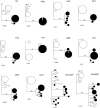Patterns of transcriptome divergence in the male accessory gland of two closely related species of field crickets
- PMID: 23172857
- PMCID: PMC3567739
- DOI: 10.1534/genetics.112.142299
Patterns of transcriptome divergence in the male accessory gland of two closely related species of field crickets
Abstract
One of the central questions in evolutionary genetics is how much of the genome is involved in the early stages of divergence between populations, causing them to be reproductively isolated. In this article, we investigate genomic differentiation in a pair of closely related field crickets (Gryllus firmus and G. pennsylvanicus). These two species are the result of allopatric divergence and now interact along an extensive hybrid zone in eastern North America. Genes encoding seminal fluid proteins (SFPs) are often divergent between species, and it has been hypothesized that these proteins may play a key role in the origin and maintenance of reproductive isolation between diverging lineages. Hence, we chose to scan the accessory gland transcriptome to enable direct comparisons of differentiation for genes known to encode SFPs with differentiation in a much larger set of genes expressed in the same tissue. We have characterized differences in allele frequency between two populations for >6000 SNPs and >26,000 contigs. About 10% of all SNPs showed nearly fixed differences between the two species. Genes encoding SFPs did not have significantly elevated numbers of fixed SNPs per contig, nor did they seem to show larger differences than expected in their average allele frequencies. The distribution of allele frequency differences across the transcriptome is distinctly bimodal, but the relatively high proportion of fixed SNPs does not necessarily imply "ancient" divergence between these two lineages. Further studies of linkage disequilibrium and introgression across the hybrid zone are needed to direct our attention to those genome regions that are important for reproductive isolation.
Figures




Comment in
-
Population genetics and a study of speciation using next-generation sequencing: an educational primer for use with "Patterns of transcriptome divergence in the male accessory gland of two closely related species of field crickets".Genetics. 2013 Mar;193(3):671-5. doi: 10.1534/genetics.112.148171. Genetics. 2013. PMID: 23463799 Free PMC article.
Similar articles
-
Differential introgression in a mosaic hybrid zone reveals candidate barrier genes.Evolution. 2013 Dec;67(12):3653-61. doi: 10.1111/evo.12205. Epub 2013 Jul 23. Evolution. 2013. PMID: 24299416
-
Genes with Restricted Introgression in a Field Cricket (Gryllus firmus/Gryllus pennsylvanicus) Hybrid Zone Are Concentrated on the X Chromosome and a Single Autosome.G3 (Bethesda). 2015 Aug 26;5(11):2219-27. doi: 10.1534/g3.115.021246. G3 (Bethesda). 2015. PMID: 26311650 Free PMC article.
-
Population genetics and a study of speciation using next-generation sequencing: an educational primer for use with "Patterns of transcriptome divergence in the male accessory gland of two closely related species of field crickets".Genetics. 2013 Mar;193(3):671-5. doi: 10.1534/genetics.112.148171. Genetics. 2013. PMID: 23463799 Free PMC article.
-
Searching for candidate speciation genes using a proteomic approach: seminal proteins in field crickets.Proc Biol Sci. 2008 Sep 7;275(1646):1975-83. doi: 10.1098/rspb.2008.0423. Proc Biol Sci. 2008. PMID: 18495616 Free PMC article.
-
Coupling of Barriers to Gene Exchange: Causes and Consequences.Cold Spring Harb Perspect Biol. 2024 Aug 1;16(8):a041432. doi: 10.1101/cshperspect.a041432. Cold Spring Harb Perspect Biol. 2024. PMID: 38191516 Review.
Cited by
-
Differential transcriptome analysis supports Rhodnius montenegrensis and Rhodnius robustus (Hemiptera, Reduviidae, Triatominae) as distinct species.PLoS One. 2017 Apr 13;12(4):e0174997. doi: 10.1371/journal.pone.0174997. eCollection 2017. PLoS One. 2017. PMID: 28406967 Free PMC article.
-
Studying the genetic basis of speciation in high gene flow marine invertebrates.Curr Zool. 2016 Dec;62(6):643-653. doi: 10.1093/cz/zow093. Epub 2016 Aug 30. Curr Zool. 2016. PMID: 29491951 Free PMC article.
-
Metazoan parasite communities: support for the biological invasion of Barbus barbus and its hybridization with the endemic Barbus meridionalis.Parasit Vectors. 2016 Nov 17;9(1):588. doi: 10.1186/s13071-016-1867-9. Parasit Vectors. 2016. PMID: 27855708 Free PMC article.
-
Dissecting cricket genomes for the advancement of entomology and entomophagy.Biophys Rev. 2022 Jan 21;14(1):75-97. doi: 10.1007/s12551-021-00924-4. eCollection 2022 Feb. Biophys Rev. 2022. PMID: 35340598 Free PMC article. Review.
-
Molecular Diversification of the Seminal Fluid Proteome in a Recently Diverged Passerine Species Pair.Mol Biol Evol. 2020 Feb 1;37(2):488-506. doi: 10.1093/molbev/msz235. Mol Biol Evol. 2020. PMID: 31665510 Free PMC article.
References
-
- Andrés J. A., Maroja L. S., Bogdanowicz S. M., Swanson W. J., Harrison R. G., 2006. Molecular evolution of seminal proteins in field crickets. Mol. Biol. Evol. 23: 1574–1584 - PubMed
-
- Apple J. L., Grace T., Joern A., Amand P. S., Wisely S. M., 2010. Comparative genome scan detects host-related divergent selection in the grasshopper Hesperotettix viridis. Mol. Ecol. 19: 4012–4028 - PubMed
-
- Avise J., 1976. Genetic differentiation during speciation, pp. 106–122 in Molecular Evolution, edited by Ayala F. J. Sinauer Associates, Sunderland, MA
Publication types
MeSH terms
Substances
LinkOut - more resources
Full Text Sources

